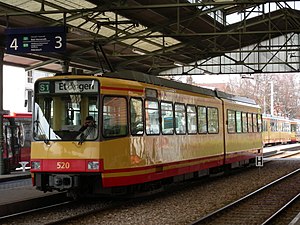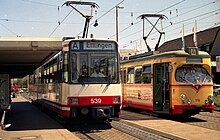GT6-80C
| GT6-80C | |
|---|---|
|
Car 520 in Ettlingen Stadt station in 2006
|
|
| Numbering: | 501-520 |
| Number: | 45 |
| Manufacturer: | Waggon Union / DUEWAG , BBC / FIG |
| Year of construction (s): | 1983-1984, 1987, 1989 |
| Retirement: | 2018-2019 |
| Axis formula : | B'2'B ' |
| Gauge : | 1435 mm ( standard gauge ) |
| Length over coupling: | 28,400 mm |
| Length: | 27,600 mm |
| Height: | 3,365 mm |
| Width: | 2,650 mm |
| Trunnion Distance: | 10,000 mm |
| Bogie axle base: | 2100 mm |
| Empty mass: | 41.9 t (501-520), 39.4 t (521-540), 39.6 t (586-590) |
| Service mass: | 59.77 t (501-520), 57.27 t (521-540), 52.4 t (586-590) |
| Top speed: | 80 km / h |
| Continuous output : | 2 × 235 kW (501-519), 2 × 280 kW |
| Power system : | 750 volts = |
| Power transmission: | Overhead line |
| Number of traction motors: | two |
| Drive: | DC motor |
| Brake: | Motor brake , spring-loaded brake , magnetic rail brake |
| Control: | Chopper control |
| Coupling type: | Scharfenberg |
| Seats: | 93 |
| Standing room: | 91 |
| Floor height: | 1000 mm |
The GT6-80C were light rail railcar , which at the Waggon Union and in DUEWAG for Karlsruhe Transport and Albtal transport company were made. The first 20 vehicles were delivered in 1983 and 1984 by Waggon Union, 20 more vehicles followed in 1987 by DUEWAG and another five in 1989 by DUEWAG. The electrical equipment was supplied by BBC or ABB .
construction
The design principle of the GT6-80C was derived from the high-floor type B light rail vehicles built by DUEWAG, which were built for numerous companies in North Rhine-Westphalia from 1973 . The two-part articulated wagon ran on two motor bogies , while the two wagon parts were supported in the middle on a Jakobs bogie .
Unlike the stadtbahnwagen b the GT6-80C were as mover carriage designed and have only one side doors. There was also only a fully equipped driver's cab, while in the rear only an auxiliary driver's cab was available. The front and rear sections were kept asymmetrical, so that the first and last door on the right side of the vehicle were in line with the other two doors, while the left side of the vehicle was retracted to avoid the lateral deflection of the vehicle when driving in tight arcs to reduce.
The two motorized bogies of wagons 501-519 were each equipped with a 235 kW direct current motor in tandem arrangement, which was regulated by a direct current controller . Since the output turned out to be too low, 520 more powerful engines with 280 kW were installed in the cars and the following vehicles were also equipped with 280 kW engines ex works. The power was supplied via a single-arm pantograph installed on the first part of the car . The electrical equipment was designed for a contact wire voltage of 750 volts direct current. The vehicles were equipped with automatic Scharfenberg couplings and a multiple traction control. They were coupling and multiple controllable railcars of the types GT8-80C , GT8-100C / 2S and GT8-100D / 2S-M , so that mixed multiple units were also possible.
The car body of the vehicles was 2.65 meters wide and thus 25 centimeters wider than the vehicles previously used by the Albtal-Verkehrs-Gesellschaft in Karlsruhe and 28 centimeters wider than those of the Karlsruhe transport company. This required some renovation work to increase the distance between the tracks on the routes in the Karlsruhe tram network that the cars traveled on.
The light rail vehicles were approved according to the tram construction and operating regulations as well as the railway building and operating regulations. That is why they had a safety driving circuit , a warning whistle and wide compromise wheel tires for tram and railroad tracks.
When delivered, the vehicles were originally painted with a yellow car body, anthracite-colored window band, anthracite-colored apron with a red decorative line and a red decorative line above the window band. From the second delivery series (from wagon 521) the apron was made in red and the existing vehicles were repainted.
history
delivery
The first delivery series between 1983 and 1984 was built by Waggon Union and equipped with electrical equipment by Brown, Boveri & Cie. From the second and third delivery series, DUEWAG took over production. From the second delivery series onwards, the electrical equipment comes from Asea Brown Boveri.
| Delivery series | dare | Construction year | number | Conversion to GT8-80C |
|---|---|---|---|---|
| 1 | 501-520 | 1983-1984 | 20th | |
| 2 | 521-540 | 1987 | 20th | 1993 (531-540), 1997 (521-530) |
| 3 | 586-590 | 1989 | 5 | 1990 |
Conversions
- 501: The 501 light rail car was converted into a two-system car for 750 V direct and 15 kV alternating voltage with a frequency of 16 2 ⁄ 3 Hz in 1986 and tested for several months. As a result of these tests, the vehicle type GT8-100C / 2S was developed. Car 501 was then dismantled again.
- 501-520: Installation of ticket machines, thus one seat less.
- 501-520: Create a multipurpose area by removing some seats. This reduced the number of seats from the original 100 to 93.
- 501–520: Installation of surveillance cameras.
- 506, 515: Restored after fire damage on December 24, 2007. Installation LED - matrix displays at the front, rear and sides (2008).
- 521–530: 1997 conversion to GT8-80C by adding another vehicle part.
- 531-540: 1993 conversion to GT8-80C.
- 539, 540: White special paint (advertisement for the State Garden Show in Ettlingen 1988).
- 586-590: 1990 conversion to GT8-80C.
commitment
The vehicles were initially used by the AVG and served from 1983 on the Albtalbahn , the Busenbach – Ittersbach and the Hardtbahn (light rail line A, since 1994 lines S1 and S11). With the VBK they were used from 1987 on the tram line 2 from Rheinstetten to Durlach . With the line network reform in 1997, the vehicles switched from tram line 2 to tram line S2. It is used both individually and in double traction and with type GT8-80C cars. In 2013, the cars were also used on tram line 5 in isolated cases. In addition, they drove on an additional trip on line 3 in the Frühspitze, the car in question was previously separated from a train on line S1 at Albtalbahnhof. Due to recurring problems with the new NET2012, the GT6-80C partly also ran on line 5 in 2016. This was the first scheduled use on the section to Rintheim, which the vehicles could not drive until the conversion to a larger track center distance. On June 5, 2017, this vehicle type was used for the last time on the S2 tram line. From March 2018 onwards, the cars will almost only run during rush hour on the S1 / S11, mostly as guided multiple units behind the GT8-80C, but until recently there have been isolated use as a solo vehicle.
Retirement
In the spring of 2018, the first wave of changes was made to the S1 and S11 tram lines due to the increasing number of NET2012s with EBO approval. This released vehicles of the type GT6-80C and GT8-80C, which were then scrapped in the depot west of the transport company. The last GT6-80C were withdrawn from the stock in the course of 2019, only car 502 remained and is intended as a historic railcar. Car 517 was originally intended to be a mobile café , but this was not implemented for cost reasons. Car 519 was handed over to the Baden-Württemberg State Fire Brigade School in Bruchsal, where it is used as a training vehicle.
literature
- 25 years of the Karlsruhe type light rail vehicle. In: The switch boy. 3, 2008, ISSN 1860-5192 , pp. 46-53.
- Axel Reuther: Album of the German tram and light rail vehicles. 1948-2005. GeraMond, Munich 2005, ISBN 3-7654-7141-0 .
- Klaus Bindewald: The Alb Valley Railway: History with a future. From the narrow-gauge railway to the modern light rail. regional culture publisher, Ubstadt-Weiher 1998, ISBN 3-929366-79-7 .
Web links
- Meeting point for local rail transport in Karlsruhe: list of trams - light rail vehicles GT6-80C 1st series
- Meeting point for local rail transport in Karlsruhe: list of trams and light rail vehicles GT6-80C 2nd series
- Meeting point for local rail transport in Karlsruhe: List of trams and light rail vehicles GT6-80C 3rd series
Individual evidence


